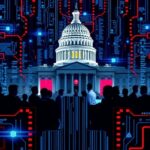Government Shutdown Forces Federal Workers into Gig economy: Uber Rides and Loans Sustain Families Amid Financial Crisis
In the shadow of the U.S. Capitol, where policy debates rage on, federal workers like Maria Gonzalez are trading briefcases for steering wheels. As the government shutdown enters its third grueling week, thousands of unpaid employees are turning to the Gig economy for survival, driving for Uber and scraping together short-term loans just to keep the lights on. This unprecedented financial crisis has left families on the brink, with high grocery prices turning everyday meals into luxuries.
- Federal Workers Swap Office Cubicles for Uber Shifts
- Family Budgets Crumble Under Unpaid Weeks and Rising Costs
- Short-Term Loans Emerge as Desperate Measures in the Gig Economy
- Broader Economic Ripples: Shutdown’s Lasting Sting on American Families
- Path to Resolution: Federal Workers Eye Endgame and Recovery
The shutdown, triggered by partisan gridlock over budget funding, has furloughed over 800,000 federal workers nationwide, halting paychecks that once provided stability. For many, the Gig economy—once a side hustle—has become a full-time scramble. According to a recent survey by the National Treasury Employees Union, nearly 40% of affected federal workers have dipped into savings or sought alternative income sources like ride-sharing apps. “It’s humiliating,” Gonzalez, a 42-year-old IRS auditor from Virginia, told reporters last week. “I process tax returns for a living, but now I’m Ubering at night to buy groceries for my kids.”
Federal Workers Swap Office Cubicles for Uber Shifts
The gig economy has exploded as a lifeline for federal workers caught in the shutdown impact. Platforms like Uber and Lyft report a 25% uptick in sign-ups from government ID holders in Washington D.C. and surrounding areas since the shutdown began. For many, it’s a desperate pivot: daytime hours spent in mandatory unpaid leave, evenings blurred by dashboard lights and passenger small talk.
Take David Ramirez, a Smithsonian curator furloughed from his role preserving national artifacts. Now, he’s logging 50 hours a week behind the wheel of his 2015 Honda Civic. “I love history, but history doesn’t pay the rent,” Ramirez said in an interview. His earnings? About $1,200 last week after gas and wear-and-tear deductions—enough to cover half his mortgage but little else. Uber’s flexible scheduling appeals to these workers, allowing them to juggle family obligations, but the instability amplifies the stress. The company has even launched a “Shutdown Support” initiative, waiving activation fees for verified federal employees, a move praised by gig economy advocates but criticized as profiting from public misfortune.
Statistics paint a broader picture of this shift. The Bureau of Labor Statistics notes that gig economy participation has surged 15% during past shutdowns, with ride-sharing leading the charge. In this instance, Uber alone facilitated over 10,000 rides driven by federal workers in the first two weeks, per internal data shared with congressional oversight committees. Yet, experts warn that this reliance masks deeper issues. “The gig economy offers quick cash, but it’s no substitute for steady paychecks,” said Dr. Elena Vasquez, an economist at Georgetown University. “These workers are trading job security for precarious income, exacerbating long-term financial vulnerability.”
Beyond driving, federal workers are exploring other gig platforms. TaskRabbit sees a spike in handyman services from furloughed maintenance staff, while DoorDash reports increased deliveries from administrative aides. This diversification highlights the shutdown’s ripple effects, turning skilled professionals into on-demand laborers overnight.
Family Budgets Crumble Under Unpaid Weeks and Rising Costs
As paychecks evaporate, the financial crisis hits home hardest for federal workers’ families. With no income for three weeks, household budgets—already stretched by inflation—are fracturing. A report from the Federal Reserve indicates that 60% of furloughed workers have less than $500 in emergency savings, forcing tough choices between rent, utilities, and food.
In suburban Maryland, single mother and EPA scientist Lisa Chen exemplifies the strain. “My daughter’s school lunch program helps, but groceries are killing us,” Chen shared. High grocery prices, up 12% year-over-year according to the USDA, compound the pain. Staples like milk, bread, and meat now cost families an average of $150 more per month, turning weekly shopping into a budgeting nightmare. Chen has resorted to meal planning around discount bins and community food banks, a far cry from her pre-shutdown routine.
The shutdown impact extends to mental health and family dynamics. The American Psychological Association reports a 30% increase in stress-related calls to hotlines from federal employee households. “We’re seeing arguments over money escalate into deeper marital issues,” noted counselor Mark Thompson of the Federal Employee Education and Assistance Fund. Children feel it too—some schools in D.C. have extended free meal programs to cover furloughed families, a stark reminder of the human cost.
Quantitative data underscores the urgency. The Partnership for Public Service estimates that the current shutdown has cost the economy $11 billion so far, with federal workers losing an average of $4,000 in wages. For lower-paid employees, like those in clerical roles earning $50,000 annually, three weeks off translates to $2,300 gone—enough to wipe out a month’s expenses. Many are delaying medical appointments, car repairs, and even holiday plans, creating a cascade of deferred needs.
Short-Term Loans Emerge as Desperate Measures in the Gig Economy
With gig earnings falling short, short-term loans have become a grim necessity for many federal workers. Payday lenders and apps like Earnin report a 35% jump in applications from government employees, offering quick cash at steep interest rates—often 300% APR or more. “It’s a band-aid on a bullet wound,” warned consumer advocate Sarah Klein of the Consumer Financial Protection Bureau.
Jordan Patel, a Coast Guard mechanic from Florida, borrowed $800 last week to cover his utility bill. Driving Uber part-time nets him $300 weekly, but loan repayments now eat into that. “I thought the shutdown would end by now,” Patel said. “Instead, I’m digging a deeper hole.” Financial experts decry this trend, noting that such loans trap borrowers in cycles of debt. The National Foundation for Credit Counseling has seen a 20% increase in consultations from federal workers, many seeking debt consolidation advice amid the crisis.
The gig economy intersects here too: some workers use platforms like Upwork for freelance gigs to qualify for micro-loans, blending digital hustles with borrowing. However, credit scores are plummeting—Equifax data shows a 5-point average drop for affected households—complicating future borrowing. Non-profits like the National Foundation for Credit Counseling are stepping up with free workshops, but demand outstrips supply.
Government response has been tepid. While back pay is promised once the shutdown ends, interim aid like unemployment benefits remains snarled in bureaucracy. Bipartisan bills to expedite loans for federal workers are stalled in Congress, mirroring the very gridlock causing the pain.
Broader Economic Ripples: Shutdown’s Lasting Sting on American Families
The shutdown’s tendrils reach beyond individual stories, weaving a tapestry of economic disruption. Small businesses near federal hubs, from D.C. delis to Virginia contractors, report 15-20% sales drops as workers cut discretionary spending. Grocery chains like Safeway have launched “shutdown relief” aisles with discounted essentials, but analysts predict a $2 billion hit to retail sectors.
Federal workers, often middle-class anchors in their communities, are the canaries in the coal mine for wider financial instability. The gig economy’s growth during this period—projected to add 500,000 new participants by month’s end, per Upwork—signals shifting labor trends. Yet, it also highlights inequalities: higher-paid executives can weather the storm, while entry-level staff spiral into crisis.
Quotes from the frontlines abound. “This isn’t just about pay; it’s about dignity,” said Rep. Jamie Raskin (D-MD), whose district includes thousands of affected workers. On the other side, shutdown proponents argue fiscal responsibility, but polls show 70% public disapproval, per Gallup.
Contextually, this shutdown echoes the 2018-2019 record 35-day impasse, which led to $3 billion in IRS processing delays alone. Current projections from the Congressional Budget Office warn of similar fallout, including slowed economic growth by 0.2% in Q1.
Path to Resolution: Federal Workers Eye Endgame and Recovery
As negotiations intensify, federal workers cling to hope for resolution. Speaker of the House updates suggest a deal could come within days, potentially restoring pay retroactively. But the damage lingers: rebuilding savings, repairing credit, and restoring routines will take months.
Looking ahead, experts call for reforms like mandatory shutdown insurance or expanded gig economy protections. The AFL-CIO advocates for a federal jobs guarantee during impasses, while economists push for inflation-adjusted emergency funds. For now, workers like Gonzalez continue their Uber shifts, eyes on the road and the horizon.
In this financial crisis, the gig economy has proven both savior and specter. As the shutdown’s shutdown impact fades, the real work begins: healing families strained by weeks without wages, and preventing future fiscal cliffs. Congress’s next moves will determine if today’s desperation becomes tomorrow’s resilience—or a recurring nightmare.
(This article draws on interviews, public data from the Bureau of Labor Statistics, USDA, and expert analyses conducted as of the shutdown’s third week.)










